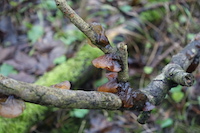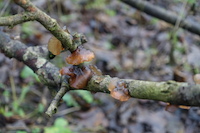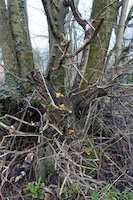January 2016
Big Garden Bird Watch
31/01/16 22:03
Last weekend in January sees the RSPB Big Garden Birdwatch. We have contributed to this for a number of years now - well over 10 - and have seen many changes in the bird population of the Lane over that time. Sadly these have not been for the better.
Overall a lower number of species seen this year compared with last. The decline of the starling continues and this is the first year in which there were no greenfinch - another declining species. No goldfinch, either. On the plus side the jay paid a visit and a song thrush was seen bathing in the pond. Both are firsts for our reporting but not new to the lane
Comparing the results:
2016 2015 2014 2013
starling 0 8 1 7
house sparrow 4 6 6 6
blackbird 2 4 3 3
long tailed tit 0 3 0 0
wood pigeon 2 2 3 2
magpie 2 2 2 1
carrion crow 2 2 1 4
chaffinch 2 2 0 0
goldfinch 0 1 6 4
greenfinch 0 1 5 5
great tit 2 1 2 3
robin 2 1 1 1
blue tit 1 1 1 1
dunnock 2 1 1 3
wren 1 1 1 0
pied wagtail 0 1 0 0
gt sp woodpecker 0 1 0 0
redwing 0 1 0 0
coal tit 0 1 0 0
LBB gull 4 0 4 0
jay 1 0 0 0
song thrush 1 0 0 0
Overall a lower number of species seen this year compared with last. The decline of the starling continues and this is the first year in which there were no greenfinch - another declining species. No goldfinch, either. On the plus side the jay paid a visit and a song thrush was seen bathing in the pond. Both are firsts for our reporting but not new to the lane
Comparing the results:
2016 2015 2014 2013
starling 0 8 1 7
house sparrow 4 6 6 6
blackbird 2 4 3 3
long tailed tit 0 3 0 0
wood pigeon 2 2 3 2
magpie 2 2 2 1
carrion crow 2 2 1 4
chaffinch 2 2 0 0
goldfinch 0 1 6 4
greenfinch 0 1 5 5
great tit 2 1 2 3
robin 2 1 1 1
blue tit 1 1 1 1
dunnock 2 1 1 3
wren 1 1 1 0
pied wagtail 0 1 0 0
gt sp woodpecker 0 1 0 0
redwing 0 1 0 0
coal tit 0 1 0 0
LBB gull 4 0 4 0
jay 1 0 0 0
song thrush 1 0 0 0
New Year Plant Hunt
28/01/16 22:18
The Botanical Society of Britain and Ireland conducted their fifth New Year Plant Hunt, in which people submit reports of wildflowers and escapes in flower between Jan 1-4th.
It had never crossed my mind that anything would be in flower at that time of year and I certainly don't remember noticing any in previous years. During the first couple of days of the year there was a pretty regular stream of pictures on Twltter of flowers so decided to take part.
Nationally there were over 8500 records of plants in flower, covering 612 different species. This is up from 368 last year, and the highest number ever recorded. But even so - 368? In January? 612 species is approx a quarter of the plants flowering regularly in Britain. about a third are aliens
Over 3/4 of records were autumn-flowering plants still in bloom in the absence of frost. Less than 1/5 were early spring flowers. Apparently both daisy and dandelion are expected to be in flower at this time of year, which was news to me.
Not surprisingly the highest number were seen from the south and west of England where the weather it milder. Urban areas gave higher reports than rural ones.
I surveyed the lane and the field then wandered over Marl Pits. I searched for an hour - a third of the maximum period permitted under the survey.
Not a thing.
The recorder said that they had very few entries from Lancashire. Perhaps that's not surprising, if my findings are generalised.
It had never crossed my mind that anything would be in flower at that time of year and I certainly don't remember noticing any in previous years. During the first couple of days of the year there was a pretty regular stream of pictures on Twltter of flowers so decided to take part.
Nationally there were over 8500 records of plants in flower, covering 612 different species. This is up from 368 last year, and the highest number ever recorded. But even so - 368? In January? 612 species is approx a quarter of the plants flowering regularly in Britain. about a third are aliens
Over 3/4 of records were autumn-flowering plants still in bloom in the absence of frost. Less than 1/5 were early spring flowers. Apparently both daisy and dandelion are expected to be in flower at this time of year, which was news to me.
Not surprisingly the highest number were seen from the south and west of England where the weather it milder. Urban areas gave higher reports than rural ones.
I surveyed the lane and the field then wandered over Marl Pits. I searched for an hour - a third of the maximum period permitted under the survey.
Not a thing.
The recorder said that they had very few entries from Lancashire. Perhaps that's not surprising, if my findings are generalised.
Jelly fungi
13/01/16 19:45
Came across this fine jelly fungus whilst out on the New Year Plant hunt. It was attached to an old ash in the Paddock.


Jelly fungi have a fruiting body with a gelatinous surround to the hyphae. This expands when wet and drys out to a thin layer which may be virtually transparent and easy to miss. With the amount of rain we have had here recently they were pretty expanded. They are all heterobasidiomycota, i.e. with septate basidia (spore-producing structure on the fruiting body of the fungus), in contrast to the majority of mushrooms for example. Apparently they can also generate self-replicating spores without having to pass via a hyphae stage. Classification seems to be both complex and changeable.
Apparently jelly fungi are paraphyletic, i.e. the group contains the group's last common ancestor and all that ancestor's descendants with the exception of a small number of that group's monoleptic groups. Very few family reconstruction studies could claim that.
I haven't attempted formal identification. It may be Orange Jelly (Dacrymyces palmatus). Or it may not. If it is, it is apparently edible but I don't think I'll bother…
The velvet shank is out also, and something has been stripping the bark off it's supporting coppiced lime.



Jelly fungi have a fruiting body with a gelatinous surround to the hyphae. This expands when wet and drys out to a thin layer which may be virtually transparent and easy to miss. With the amount of rain we have had here recently they were pretty expanded. They are all heterobasidiomycota, i.e. with septate basidia (spore-producing structure on the fruiting body of the fungus), in contrast to the majority of mushrooms for example. Apparently they can also generate self-replicating spores without having to pass via a hyphae stage. Classification seems to be both complex and changeable.
Apparently jelly fungi are paraphyletic, i.e. the group contains the group's last common ancestor and all that ancestor's descendants with the exception of a small number of that group's monoleptic groups. Very few family reconstruction studies could claim that.
I haven't attempted formal identification. It may be Orange Jelly (Dacrymyces palmatus). Or it may not. If it is, it is apparently edible but I don't think I'll bother…
The velvet shank is out also, and something has been stripping the bark off it's supporting coppiced lime.

New Year Plant Hunt
04/01/16 18:26
The Botanical Society for Britain and Ireland hold a New Year Plant Hunt in which volunteers study their patch for 1-3 hours between January 1st and 4th, looking for higher plants in flower. This was the first year I had come across this survey and, inspired by the pictures on social media of numerous plants in flower in various parts of the country I trotted off for a gander along the Lane and New Cross Meadow armed with a notebook and a camera.
There wasn't a single plant in flower. Not one. Whilst the survey is only looking at wild and naturalised species, there wasn't even a garden plant in flower.
In a way I shouldn't have been surprised. The patch is mainly clay ground which saturates easily and is currently waterlogged. It is also a wilding meadow which is showing signs of previous nitrogen enrichment with a preponderance of N2 loving species.
Previous results suggest that urban areas with sheltered corners, plants with 'high seed production' flowers and garden escapes tend to produce high returns. Not here, then. It will be interesting when this year's results are in to see whether anyone found anything in flower in East Lancs.
There wasn't a single plant in flower. Not one. Whilst the survey is only looking at wild and naturalised species, there wasn't even a garden plant in flower.
In a way I shouldn't have been surprised. The patch is mainly clay ground which saturates easily and is currently waterlogged. It is also a wilding meadow which is showing signs of previous nitrogen enrichment with a preponderance of N2 loving species.
Previous results suggest that urban areas with sheltered corners, plants with 'high seed production' flowers and garden escapes tend to produce high returns. Not here, then. It will be interesting when this year's results are in to see whether anyone found anything in flower in East Lancs.
First fauna of the year
01/01/16 22:02
Quiet start to the New Year with two blackbirds and one squirrel seen on the lane today. A little surprising as there were a large number of rabbits around in the days over Christmas and the jay has been pretty much in evidence recently.




